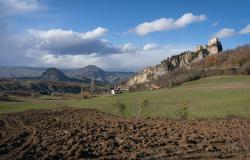No area in the European Alps is as rich in legends as the Italy's Dolomite mountains, according to leading anthropologists.
A strange spell shrouds the Pale Mountains, an austere ancient world where man has been subjugated by the inaccessible magic peaks, continuously changing form and colour, mysterious places inhabited by both gods and evil spirits, according to the people who live there.
''On the other side of the highest summer pastures begins the unknown, another world, a world where the collective imagination once set legends born out of ancestral fears and inexplicable events, fascinating echoes from the past, even for the most sceptic.'' writes Ulrike Kindl.
''When the setting sun falls on the jagged peaks or a veil of fog appears in the woods, the images of legend rise up from the marvellous Dolomites landscapes,'' he added.
The author of 'The Dolomites in Legend', Kindl is one of Italy's most respected folklore scholars and has written extensively on the importance of legends and folklore in the Dolomite's Ladin valleys.
Most historians believe the Ladin people - still living in the Dolomite mountains, still speaking the Ladin language and conserving their culture, customs and traditions - descend from of an ancient Iron Age tribe conquered by the Romans in 15 BC and which later endured Celtic, Frank and Bavarian invasions.
Ladin oral tradition is very rich, offering many historical legends and tales of the natural world that have been handed down from generation to generation.
The most substantial Ladin presence today is in the heart of the Dolomites, in the Fassa, Gardena, Badia-Marebbe, and Fodom-Livinallongo valleys, parts of the mountain groups included in Italy's bid for the Dolomites to be named a World Heritage Site.
In 1972 the United Nations Educational Scientific and Cultural Organization (UNESCO) adopted an international treaty to identify and protect cultural and natural heritage.
The mission to preserve heritage considered to have outstanding value to humanity is carried out by the World Heritage Committee, scheduled to rule on the Dolomite bid by the end of June.
Italy's 2008 application to get its famous mountains a spot on the prestigious list was indorsed by the International Union for the Conservation of Nature (IUCN) in May.
Nine mountain groups, including Ladin areas in the provinces of Bolzano and Trento, have been selected as representative of two UNESCO criteria: superlative natural phenomena and outstanding examples representing major stages of earth's history.
The first to collect fragments of the ancient legends was the journalist Karl Felix Wolff who travelled from valley to valley in the early 1900s to question older farmers and shepherds.
His enormously successful book, The Pale Mountains, was the first real collection of Dolomite legends and today the Dolomite Alps are often called The Pale Mountains.
Born in 1879 to an Austrian army officer and a woman from the one of the Trento valleys, as a child Wolff was fascinated by the stories his nanny told him about her home in the Val di Fassa.
Later Wolff tried to connect fragmentary pieces of the tales and reconstruct a complex epic reminiscent of German epic poems and the tales of King Arthur.
Criticised by some scholars for not using a scientific method in collecting and documenting sources, Wolff's contribution is recognized by many historians as invaluable in rescuing a native heritage which otherwise may well have disappeared completely.
Before Wolff Dolomites stories and legends had been studied by the anthropologist Nepomuceno Bolognini working in the Brento Dolomites, by Felice Valentini in the Val di Fassa, Don Lorenzo Felicetti in the Val di Fiemme, Tita Alton in the Val Badia and Hugo de Rossi, an Innsbruck resident originally from the Fassa Valley.
More recently research has been done by Giovanna Borzaga from Trento, Bruna Maria Dal Lago from Bolzano and the writer and journalist Mauro Neri from Trento.
Neri gathered thousands of legends from the Trentino region including many from the Dolomites, patiently examining archives, documents, previous studies and publications.
The Dolomite legends contain elements of ancient history as well as folk interpretations of natural phenomena. The complex oral heritage has roots in various periods of time, from prehistory to the beginning of human civilization, from the Roman conquests to the barbarian invasions from the north.
The tales of the mysterious Reign of the Fanes tell how the flourishing kingdom was founded by a princess, the daughter of a water nymph who made a pact with the forest's groundhog-like marmots.
The Reign of Aurona, recalling epic poems about magical hidden mines, is populated by gnomes endowed with a special talent for finding treasure. Some legends refer to the men led by Drusus, a stepson of the emperor Augustus and one of the Roman generals who conquered the area and forced the ancient Raetians to adopt Roman ways.
Whether it involves rainbows thrown in the Carezza Lake by a powerful magician or moonbeams sewn together by mythical beasts to light up the mountains and cure the Moon King's melancholy daughter - the most beautiful images in the legends are explanations of the famous Dolomite Aplenglow.
This optical phenomena occurs when the sun, just below the horizon, produces a glowing red band on the opposite horizon.
One of the most popular tales is about the beautiful red roses that once bloomed on the Rose Garden, a mountain called the Rosengarten in German and the Catinaccio in Italian.
The king of this flowering garden, taken prisoner by Ostrogoth king Theodoric the Great, put the garden under a spell and changed it into bare rock to prevent anyone from seeing his roses, ''either during the day or at night''.
As he forgot to mention dawn and dusk, visitors can still see the king's roses when the rocks turn a fiery red just before sunrise and just after sunset.






